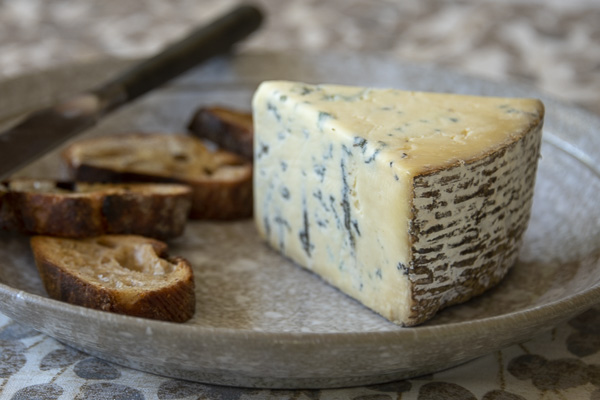The mission: to create a luscious Gorgonzola-style cheese, more creamy than crumbly. An American Gorgonzola dolce, the young cheesemaker imagined. He had tried that spreadable Italian cheese for the first time and fallen in love. “And that’s how it started,” says Joe Moreda of the first cheese he has shepherded from idea to reality. “I told my mom I would like to make it, and she said, ‘Let’s go for it.’” Three years later the world has a new blue cheese.
Making commercially acceptable cheese is no cakewalk, but blue cheese is even more finicky. I know at least one highly accomplished cheesemaker who gave up after working on a blue for years. You have to treat the curds gently for a creamy texture and to leave pockets of air where the blue mold can grow. But work too gently and the wheel may fall apart. You have to determine when the interior is sufficiently blue and then stop the mold’s progression. And if you produce other cheeses, you have to be able to segregate the blue or you’ll soon see Penicillium roqueforti on everything you make.
Joe Moreda with Karen Bianchi-Moreda
“Trying to find that happy medium has been tough,” says Moreda, head cheesemaker for Valley Ford Cheese Company, the California creamery his mother launched ten years ago.
Grazing Girl (above) doesn’t resemble Gorgonzola dolce. But who cares? It’s delicious: dense and buttery, with an aroma of Saltine crackers, buttered toast and warmed nuts. To me it comes closer to a robust Stilton, with its natural rind and mellow finish. It spreads smoothly and melts on the tongue. Bravo, Joe.
Moreda, a graduate of Cal Poly’s dairy science program, is the fifth generation to work on his family’s century-old dairy farm. His Swiss-Italian great great-grandfather settled in Valley Ford, in scenic western Sonoma County, in 1918. Moreda’s mother, Karen Bianchi-Moreda, a former physical-education teacher, bought a home-cheesemaking kit ten years ago, hoping to create a role for herself on the farm.
Her two creations—the delightful Estero Gold and Highway One—have made the cheesemaking enterprise a success. Now her two boys are stepping into their own roles—Joe as cheesemaker and Jim, who studied animal husbandry at Cal Poly and grazing practices in New Zealand, as the cow guy and pasture expert. All three cheeses are made exclusively with the farm’s raw Jersey milk.
Joe moves Grazing Girl into a detached aging room on day two. That’s where the four-pound wheels are hand salted and, after seven days, pierced with needles to provide air and activate the blue mold. Moreda says he nailed the recipe 18 months ago but the cheese was peaking at 30 days, a month too young for legal raw-milk cheese. He had to figure out how to slow it down. He got a lot of advice from Kuba Hemmerling, the cheesemaker at nearby Point Reyes Farmstead Cheese, which produces two blues. That’s the generous California spirit. Now Valley Ford is releasing Grazing Girl at three months.
Availability will grow but, for now, look for Grazing Girl at these California retailers: Big John’s (Healdsburg); McCall’s Meat & Fish (Los Angeles); Bi-Rite and Rainbow Grocery (San Francisco); Venissimo (San Diego area); Molsberry Market and Palace Market (Santa Rosa); Oliver’s Markets (all Santa Rosa-area locations) and Cheesemonger of Sherman Oaks.
Italianissimo!
Thursday, June 21
Trefethen Family Vineyards
1160 Oak Knoll Aveune,
Napa, CA 94558
5:30 p.m. to 7:30 p.m
Reserve >
From the Italian Alps to Sicily’s sheep farms, Italy is cheese country. Seems like every little village has its own pecorino or robiola or cave-aged blue. We’ll meander the back roads of the Italian “boot,” tasting small-production cheeses that I bet you don’t know and some superior versions of the classics. The country that gave us Parmigiano-Reggiano has so many more cheeses to love.



